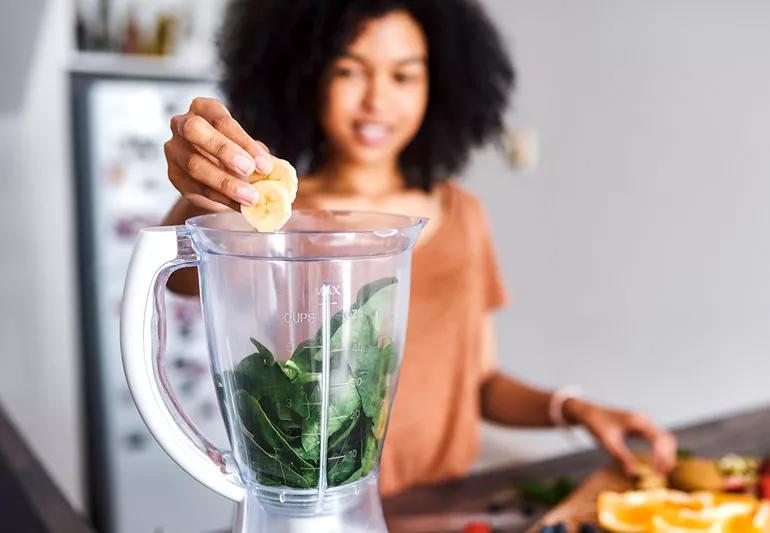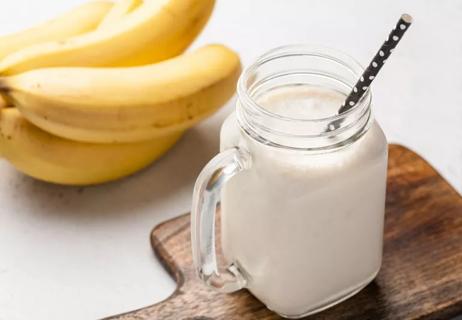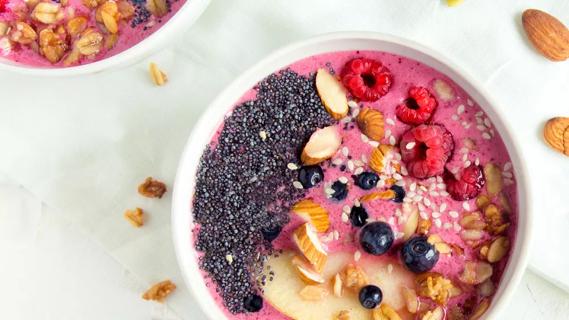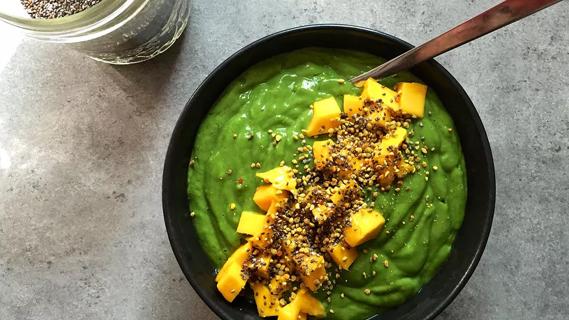Plus 12 recipes that taste great

Smoothies may seem like a no-brainer. Just fill a blender with fruit, ice and milk or juice, and let ‘er rip.
Advertisement
Cleveland Clinic is a non-profit academic medical center. Advertising on our site helps support our mission. We do not endorse non-Cleveland Clinic products or services. Policy
But upset the smoothie balance, and you’re suddenly eating 1,000 calories instead of 400. Or maybe you’re crashing after a barely-there surge in energy.
“Smoothies can easily go from super healthy to calorie minefield,” notes registered dietitian Anna Taylor.
So what are the healthiest things to put in a smoothie? Taylor says these six smoothie staples will make a drink that’s delicious, nutritious and filling.
Fruit is a great source of vitamins, minerals and heart-healthy antioxidants. But women only need two to three servings per day. Men need three to four. “About 3/4 cup of fresh or frozen fruit equals one serving, and one large banana counts as two,” says Taylor.
Great fruits to try in your smoothie include:
Berries come with a bonus: “Raspberries, blueberries, strawberries and other berries add a sweet and tart flavor, and their fiber helps you stay full,” says Taylor. “Berries also contain antioxidants, which research suggests may have cancer-fighting properties. And because they’re low on the glycemic index, berries won’t spike your blood sugar as quickly as other fruits do.”
Advertisement
Other tips for adding fruit to your smoothies:
Fresh veggies are a perfect smoothie addition — they’re an awesome source of vitamins and minerals with very few calories. While they may make your smoothie less sweet, Taylor says that getting away from too much sweetness in your diet is a worthy goal.
Spinach and kale are great in smoothies. They’re low in sugars and calories and provide more iron and protein than fruit does. They’re also bursting with fiber, folate and phytonutrients such as carotenoids, saponins and flavonoids.
But if you’re bold with your veggie selections, you may just find your new favorite flavor profile. Taylor recommends stepping out of your comfort zone and mixing in:
“Cruciferous vegetables like cabbage and bok choy are my favorite ingredients to add. These nutrient-rich gems contain glucosinolates, an anti-inflammatory phytonutrient,” says Taylor. Research has also linked glucosinolates to a lower risk of certain cancers.
Studies show that most Americans struggle to eat the recommended three-to-five servings a day. “Smoothies are an incredibly easy way to increase your overall vegetable consumption because you can’t taste them,” she says. Veggies can help:
Pack multiple servings of protein, a great energy source, into each smoothie. This will stabilize your blood sugar and keep you full.
Great protein options include:
Dairy products can help make your smoothie a true meal replacement that keeps you satisfied. “Plain Greek yogurt is a nice alternative to protein powders, which often come with added flavors and sugars,” says Taylor.
She recommends plain Greek yogurt, which has almost double the protein of other yogurts. For fewer calories, choose nonfat or 1% plain.
Nut butters, nuts and seeds provide protein — and heart-healthy fat. “Most smoothies provide carbohydrates and protein but lack fat,” notes Taylor. “Fat helps slow your digestion, which will help you stay fuller longer.”
Choose natural peanut or almond butter (all peanuts or almonds, no fillers), or add walnut halves to boost your omega-3 intake. But because nuts, seeds and nut butters are high in calories, “be mindful of portion sizes,” cautions Taylor. “Add no more than 1/2 ounce of nuts or seeds or 1 tablespoon of nut butter per serving.” For reference, eight walnut halves equal 1/2 ounce.
Advertisement
Ground flaxseed is another great option. “It’s a source of omega-3 fat and provides extra protein and fiber,” says Taylor. Two tablespoons contain 60 calories, 4.5 grams of unsaturated fat, 3 grams of protein, and 4 grams of fiber.
“Because extra fiber also helps with bowel regularity, you may want to start with a small serving. Then increase, as desired, up to 2 tablespoons per day.”
If you want to try chia seeds instead, try 1 tablespoon in your smoothie. The serving contains 70 calories, 2.5 grams of protein and 5 grams of fiber.
Another way to add a healthy fat to your smoothie other than nuts and seeds? Try 1/4 of an avocado (about 80 calories). It adds a creamy texture along with 5.5 grams of healthy, unsaturated fats and 3 grams of fiber.
If you want to add liquid to your smoothie, rethink juice. “The nutritional magic of fruit is in the fiber. Juice removes the fiber, leaving just water and sugar,” says Taylor. “The added sugars from fruit juice provide calories without much nutrition and are linked to weight gain. But if you simply can’t live without it, use no more than 4 ounces of 100%, calcium-fortified juice.”
Or try these more nutritious alternatives:
Advertisement
Taylor advises avoiding canned coconut milk: “It’s sky-high in saturated fat.”
Spices add flavor to your smoothie without the calories of honey and other sweeteners. They also have health benefits: Cinnamon helps fight inflammation, and ginger aids digestion, for example.
For some additional pizzazz, Taylor recommends adding these flavors:
Hailed as a superfood, spirulina is a type of blue-green sea algae. In dried powder form, it’s also a nutrient powerhouse — but it’s not for everyone.
“Spirulina offers a ton of nutrient density without packing in the calories and sugar,” explains Taylor. “I recommend adding 1 to 2 tablespoons to a smoothie.”
Two tablespoons contain just 40 calories, 3.4 grams of carbohydrates and 0.5 grams of fiber, but provide 8 grams of protein because it’s so rich in amino acids.
But here are some caveats:
Advertisement
Use these recipes or build from them to create your own.
The sweetness of the bananas balances kale’s slight bitterness in this recipe. Use just a tiny pinch of cloves — they’re potent!
Get the banana-kale wake-up smoothie recipe.
It’s nutty. It’s sweet. And it’s good for you. Blast off your day with healthy fats, antioxidants and phytonutrients from this creamy creation.
Get the ruby-red raspberry smoothie recipe.
You would never guess this creamy, high-protein smoothie gets its texture from tofu and cashew butter. Hey, don’t knock it till you try it!
Get the creamy kiwi-lime smoothie recipe.
Ready to trade in the smoothie glass for a bowl and spoon? In this bowl, the leafy green goodness of spinach meets the sweetness of grapes, mango, apple and banana.
Get the go green smoothie bowl recipe.
You’ll feel like you’re on the beach with this zesty blend of mango, coconut, lime and strawberries. This vegan smoothie is high in potassium and features beneficial phytonutrients.
Get the cool tropical smoothie recipe.
This satisfying smoothie is sweetened with strawberries, “creamified” with avocado and then exalted to green goddess status with arugula.
Get the creamy strawberry and greens smoothie recipe.
Enjoy this refreshing, tasty drink for breakfast or a snack. You can build from this recipe and modify it with different fruit such as strawberries, or you can use a low-fat soy milk or skim milk.
Get the peach-vanilla yogurt smoothie recipe.
Berry vanilla goodness, low-fat dairy and bananas fill this smoothie. It’s smooth, creamy and sweet. Blend it up for breakfast to make your morning magical.
Get the berry vanilla banana smoothie recipe.
This smoothie will entice you with mango, grapes, strawberries and peaches while including various veggies, yogurt and chia seeds. Blend one up for yourself, your partner or your children — all the sweethearts in your life deserve it.
Get the mango strawberry sweetheart smoothie recipe.
This delicious, healthy smoothie features spinach and kale — the cancer-fighting greens that keep you going — as well as sweet grapes, pear, orange and banana.
Get the green grape smoothie recipe.
Try this vitamin C-packed juicy peach and orange juice smoothie. This cool treat is antioxidant-rich, supporting your immune system while promoting healthy skin and wound healing.
Get the refreshing peach-orange smoothie recipe.
Go bananas for this sweet smoothie recipe that includes low-fat dairy products. Combine it with fresh or canned soft fruits to provide calcium and protein.
Get the sweet banana smoothie recipe.
Learn more about our editorial process.
Advertisement

Opt for nutrient-dense, fiber-filled and protein-rich ingredients to reap the benefits of these healthy bowls

Packed with protein, healthy fat, vitamins and minerals, this smoothie will help keep you energized for your day!

A dreamy-creamy, delicious way to fuel your day

A creamy smoothie with crunchy toppings — in a bowl!

With leafy green spinach, sweet mango and green grapes, this smoothie will refresh and replenish you

The best parenting style balances enforcing rules and showing plenty of love

Tips include cutting back on sugar, focusing on exercise and managing stress

It can be harder to let go when you’ve invested time, energy and emotions — but it might be the healthier choice long term